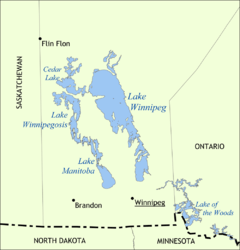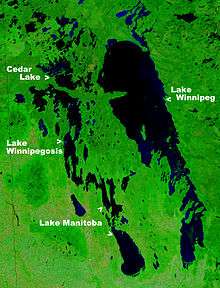Lake Winnipeg
| Lake Winnipeg | |
|---|---|
 Map | |
| Location | Manitoba, Canada |
| Coordinates | 52°7′N 97°15′W / 52.117°N 97.250°WCoordinates: 52°7′N 97°15′W / 52.117°N 97.250°W |
| Type | Formerly part of the glacial Lake Agassiz, reservoir |
| Primary inflows | Winnipeg River, Saskatchewan River, Red River |
| Primary outflows | Nelson River |
| Catchment area | 982,900 km2 (379,500 sq mi) |
| Basin countries | Canada, United States |
| Max. length | 416 km (258 mi) |
| Max. width |
100 km (60 mi) (N Basin) 40 km (20 mi) (S Basin) |
| Surface area | 24,514 km2 (9,465 sq mi) |
| Average depth | 12 m (39 ft) |
| Max. depth | 36 m (118 ft) |
| Water volume | 284 km3 (68 cu mi)[1] |
| Residence time | 3.5 years [2] |
| Shore length1 | 1,858 km (1,155 mi) |
| Surface elevation | 217 m (712 ft) |
| Settlements | Gimli, Manitoba |
| 1 Shore length is not a well-defined measure. | |
Lake Winnipeg (French: Lac Winnipeg) is a very large, but relatively shallow 24,514-square-kilometre (9,465 sq mi) lake in central North America, in the province of Manitoba, Canada, with its southern tip about 55 kilometres (34 mi) north of the city of Winnipeg. It is the largest lake within southern Canada's borders, and it is part of the most undeveloped large watershed of southern Canada.
Lake Winnipeg is Canada's sixth-largest freshwater lake,[3] and the third-largest freshwater lake contained entirely within Canada, but it is relatively shallow (mean depth of 12 m (39 ft))[4] excluding a narrow 36 m (118 ft) deep channel between the northern and southern basins. It is the eleventh-largest freshwater lake on Earth. The lake's east side has pristine boreal forests and rivers that are being promoted as a potential United Nations World Heritage Park. The lake is elongated and is 416 km (258 mi) from north to south, with remote sandy beaches, large limestone cliffs, and many bat caves in some areas. Manitoba Hydro uses the lake as one of the largest reservoirs in the world. There are many islands, most of them undeveloped.
Hydrography

The lake's watershed measures about 982,900 square kilometres (379,500 sq mi),[5] and covers much of Alberta, Saskatchewan, Manitoba, northwestern Ontario, Minnesota, and North Dakota. Its drainage is about 40 times larger than its surface, a ratio bigger than any other large lake in the world. Given the massive watershed and the relatively small volume of water in the lake, it is dominated by events in its watershed. It is not surprising to find it showing the effects of materials being added to it as a result of activities in the watershed.
Lake Winnipeg drains northward into the Nelson River at an average annual rate of 2,066 cubic metres per second (72,960 cu ft/s), and forms part of the Hudson Bay watershed, which is one of the largest in the world. This watershed area was historically known as Rupert's Land when the Hudson's Bay Company was chartered in 1670.
Tributaries

The Saskatchewan River flows in from the west through Cedar Lake, the Red River (including Assiniboine River) flows in from the south and the Winnipeg River (draining Lake of the Woods, Rainy River and Rainy Lake) enters from the southeast. The Dauphin River enters from the west draining Lake Manitoba and Lake Winnipegosis.
The Bloodvein River, Berens River, Poplar River and the Manigotagan River flow in from the eastern side of the lake which is within the Canadian Shield.
Other tributaries of Lake Winnipeg (clockwise from the south end) include; Meleb Drain (drainage canal), Drunken River, Icelandic River, Washow Bay Creek, Sugar Creek, Beaver Creek, Mill Creek, Moose Creek, Fisher River, Jackhead River, Kinwow Bay Creek, Jackpine Creek, Mantagao River, Solomons Creek, Jumping Creek, Warpath River, South Two Rivers, North Two Rivers, South Twin Creek, North Twin Creek, Saskachaywiak Creek, Eating Point Creek, Woody Point Creeks, Muskwa Creek, Buffalo Creek, Fiddler Creek, Sturgeon Creek, Hungry River, Cypress Creek, William River, Bélanger River, Mukutawa River, Crane Creek, Kapawekapuk Creek, Marchand Creek, Leaf River, Pigeon River, Taskapekawe Creek, Bradbury River, Petopeko Creek, Loon Creek, Sanders Creek, Rice River, Wanipigow River, Barrie Creek, Mutch Creek, Sandy River, Black River, Sandy Creek, Catfish Creek, Jackfish Creek, Marais Creek, Brokenhead River and Devils Creek.[6][7]
Geography
Communities
Communities on the lake include Grand Beach, Lester Beach, Riverton, Gimli, Winnipeg Beach, Victoria Beach, Hillside beach, Pine Falls, Manigotagan, Berens River, Bloodvein, Sandy Hook, Albert Beach, Hecla Village and Grand Rapids. A number of pleasure beaches are found on the southern end of the lake, which are popular in the summer, attracting many visitors from Winnipeg, about 80 km south.

Environmental issues
Lake Winnipeg is suffering from many environmental issues such as an explosion in the population of algae, caused by excessive amounts of phosphorus seeping into the lake, therefore not absorbing enough nitrogen.[8][9] The phosphorus levels are approaching a point that could be dangerous for human health.[10]
The Global Nature Fund has declared Lake Winnipeg as the "threatened lake of the year" for 2013.[11]
In 2015, there was a major explosion of zebra mussels in Lake Winnipeg, the reduction of which is next to impossible due to a lack of natural predators in the lake. The mussels are devastating to the ecological opportunities of the lake. [12]
History
Lake Winnipeg and Lake Manitoba are remnants of prehistoric Glacial Lake Agassiz, although there is evidence of a desiccated south basin of Lake Winnipeg approximately 4000 years ago. The area between the lakes is called the Interlake Region, and the whole region is called the Manitoba Lowlands.
It is believed Henry Kelsey was the first European to see the lake, in 1690. He adopted the Cree language name for the lake: wīnipēk (ᐐᓂᐯᐠ), meaning "muddy waters". La Vérendrye referred to the lake as Ouinipigon when he built the first forts in the area in the 1730s. Later, the Red River Colony to its south took the lake's name for Winnipeg, the capital of Manitoba.
Lake Winnipeg lies along one of the oldest trading routes in North America to have flown the British flag. For several centuries, furs were traded along this route between York Factory on Hudson Bay[13] (which was the longtime headquarters for the Hudson's Bay Company) over Lake Winnipeg and the Red River Trails to the confluence of the Minnesota and Mississippi Rivers at Saint Paul, Minnesota. This was a strategic trading route for the First British Empire. With the establishment of the Second British Empire after Britain's loss of the Thirteen Colonies, a significant increase in trade occurred over Lake Winnipeg between Rupert's Land and the United States.
Transportation
Because of its length, the Lake Winnipeg water system and the lake was an important transportation route in the province before the railways reached Manitoba. It continued to be a major transportation route even after the railways reached the province. In addition to aboriginal canoes and York boats, several steamboats plied the lake, including Anson Northup, City of Selkirk, Colvile, Keenora, Premier, Princess, Winnitoba, Wolverine and most recently the diesel powered MS Lord Selkirk II passenger cruise ship.
Ecology
Commercial fisheries
Lake Winnipeg has important commercial fisheries. Its catch makes up a major part of Manitoba's $30 million-a-year fishing industry.[14] The lake was once the main source of goldeye in Canada, which is why the fish is sometimes called Winnipeg goldeye. Common carp were introduced to the lake through the Red River of the North and are firmly established. Walleye and whitefish together account for over 90 percent of its commercial fishing.[15]
See also
Notes
- ↑ "Lake Winnipeg Quick Facts". Retrieved 14 July 2014.
- ↑ Massive flood expected to take toll on Lake Winnipeg, feed algae blooms Winnipeg Free Press
- ↑ Great Canadian Lakes
- ↑ International Lake Environment Committee Archived 10 February 2007 at the Wayback Machine.
- ↑ "Canada Drainage Basins". The National Atlas of Canada, 5th edition. Natural Resources Canada. 1985. Retrieved 12 November 2014.
- ↑ "Natural Resources Canada-Canadian Geographical Names (Lake Winnipeg)". Retrieved 2014-12-28.
- ↑ "Atlas of Canada Toporama". Retrieved 2014-12-28.
- ↑ $1.1M for Lake Winnipeg - Winnipeg Free Press
- ↑ Canada’s sickest lake, MacLean's Magazine
- ↑ "Lake Winnipeg at 'tipping point': report". CBC News. 31 May 2011.
- ↑ "Lake Winnipeg declared threatened lake of the year". Winnipeg Free Press. 5 February 2013.
- ↑ Lake Winnipeg a lost cause - CBC Online
- ↑ Fur Trade Canoe Routes of Canada/ Then and Now by Eric W. Morse Canada National and Historic Parks Branch, first printing 1969.
- ↑ Manitoba Water Stewardship - Fisheries
- ↑ "A profile of Manitoba's commercial fishery" (PDF). Manitoba Water Stewardship (Department, Government of Manitoba). 14 May 2010. Retrieved 2011-07-29.
References
- Canadian Action Party (2006) Canadian action party release Devils Lake ruling
- Casey, A. (November/December 2006) "Forgotten lake", Canadian Geographic, Vol. 126, Issue 6, pp. 62–78
- Chliboyko, J. (November/December 2003) "Trouble flows north", Canadian Geographic, Vol. 123, Issue 6, p. 23
- Economist, "Devil down south" (16 July 2005), Vol. 376, Issue 8435,. p. 34
- GreenPeace, "Algae bloom on Lake Winnipeg" (26 May 2008). Retrieved 2 February 2009
- Daily Commercial News and Construction Record, "Ottawa asked to help block water diversion project: Devils Lake outlet recommended by U.S. Army Corps of Engineers" (20 October 2003), Vol. 76, Issue 198,. p. 3
- Sexton, B. (2006) "Wastes control: Manitoba demands more scrutiny of North Dakota’s water diversion scheme", Outdoor Canada, Vol. 34, Issue 1, p. 32
- Warrington, Dr. P. (6 November 2001) "Aquatic pathogens: cyanophytes"
- Welch, M. A. (19 August 2008) "Winnipeg’s algae invasion was forewarned more than 30 years ago", The Canadian Press
- Macleans (14 June 2004) "What ails Lake Winnipeg" Vol. 117, Issue 24, p. 38.
- Wilderness Committee (2008) "Turning the tide on Lake Winnipeg and our health"
External links
![]() Media related to Lake Winnipeg at Wikimedia Commons
Media related to Lake Winnipeg at Wikimedia Commons
- The Canadian Encyclopedia
- Lake Winnipeg Research Consortium
- Manitoba Water Stewardship - Lake Winnipeg
- Satellite images of Lake Winnipeg
- Sail Lake Winnipeg